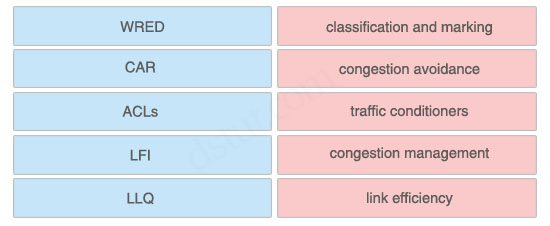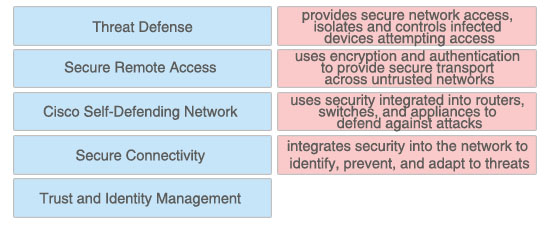Drag and Drop Questions
Here you will find answers to Drag and Drop Questions
Question 1
Click and drag the QoS feature type on the left to the category of QoS mechanism on the right.

Answer:
+ classification and marking: ACLs
+ congestion avoidance: WRED
+ traffic conditioners: CAR
+ congestion management: LLQ
+ link efficiency: LFI
Explanation
Classification is the process of partitioning traffic into multiple priority levels or classes of service. Information in the frame or packet header is inspected, and the frame’s priority is determined.Marking is the process of changing the priority or class of service (CoS) setting within a frame or packet to indicate its classification. Classification is usually performed with access control lists (ACL), QoS class maps, or route maps, using various match criteria.
Congestion-avoidance techniques monitor network traffic loads so that congestion can be anticipated and avoided before it becomes problematic. Congestion-avoidance techniques allow packets from streams identified as being eligible for early discard (those with lower priority) to be dropped when the queue is getting full. Congestion avoidance techniques provide preferential treatment for high priority traffic under congestion situations while maximizing network throughput and capacity utilization and minimizing packet loss and delay.
Weighted random early detection (WRED) is the Cisco implementation of the random early detection (RED) mechanism. WRED extends RED by using the IP Precedence bits in the IP packet header to determine which traffic should be dropped; the drop-selection process is weighted by the IP precedence.
Traffic conditioner consists of policing and shaping. Policing either discards the packet or modifies some aspect of it, such as its IP Precedence or CoS bits, when the policing agent determines that the packet meets a given criterion. In comparison, traffic shaping attempts to adjust the transmission rate of packets that match a certain criterion. Shaper typically delays excess traffic by using a buffer or queuing mechanism to hold packets and shape the flow when the source’s data rate is higher than expected. For example, generic traffic shaping uses a weighted fair queue to delay packets to shape the flow. Traffic conditioner is also referred to as Committed Access Rate (CAR).
Congestion management includes two separate processes: queuing, which separates traffic into various queues or buffers, and scheduling, which decides from which queue traffic is to be sent next. There are two types of queues: the hardware queue (also called the transmit queue or TxQ) and software queues. Software queues schedule packets into the hardware queue based on the QoS requirements and include the following types: weighted fair queuing (WFQ), priority queuing (PQ), custom queuing (CQ), class-based WFQ (CBWFQ), and low latency queuing (LLQ).
LLQ is also known as Priority Queuing–Class-Based Weighted Fair Queuing (PQ-CBWFQ). LLQ provides a single priority but it’s preferred for VoIP networks because it can also configure guaranteed bandwidth for different classes of traffic queue. For example, all voice call traffic would be assigned to the priority queue, VoIP signaling and video would be assigned to a traffic class, FTP traffic would be assigned to a low-priority traffic class, and all other traffic would
be assigned to a regular class.
Link efficiency techniques, including link fragmentation and interleaving (LFI) and compression. LFI prevents small voice packets from being queued behind large data packets, which could lead to unacceptable delays on low-speed links. With LFI, the voice gateway fragments large packets into smaller equal-sized frames and interleaves them with small voice packets so that a voice packet does not have to wait until the entire large data packet is sent. LFI reduces and ensures a more predictable voice delay.
(Reference: Cisco Press Designing for Cisco Internetwork Solutions)
Question 2
Click and drag the Cisco Self-Defending Network term on the left to the SDN description on the right. Not all terms will be used.

Answer:
+ provides secure network access, isolates and controls infected devices attempting access: Trust and Identity Management
+ uses encryption and authentication to provide secure transport across untrusted networks: Secure Connectivity
+ uses security integrated into routers, switches, and appliances to defend against attacks: Threat Defense
+ integrates security into the network to identify, prevent, and adapt to threats: Cisco Self-Defending Network
Explanation
Trust and identity management solutions provide secure network access and admission at any point in the network and isolate and control infected or unpatched devices that attempt to access the network. If you are trusted, you are granted access.
We can understand “trust” is the security policy applied on two or more network entities and allows them to communicate or not in a specific circumstance. “Identity” is the “who” of a trust relationship.
The main purpose of Secure Connectivity is to protect the integrity and privacy of the information and it is mostly done by encryption and authentication. The purpose of encryption is to guarantee confidentiality; only authorized entities can encrypt and decrypt data. Authentication is used to establish the subject’s identity. For example, the users are required to provide username and password to access a resource…
Question 3
Match the Cisco security solution on the left to its function on the right.

Answer:
+ protects the endpoints (desktops, laptops and servers): Cisco Security Agent
+ provides multiple functions as a high performance security appliance: ASA
+ prevents DDoS attacks: Anomaly Guard and Detector
+ provides Web-Based VPN services: SSL Service Module
+ prevents attacks inline: IPS Appliance
Question 4

Answer:
+ limits the number of frames transmitted before an acknowledgement is received: window size
+ reduces data size to save transmission time, optimizing the use of WAN bandwidth: data compression
+ allows network administrators to manage the varying demands generated by applications: queuing
+ discards packets or modifies some aspect of them (such as IP precedence): traffic policing
Question 5
Place the PPDIOO Methodology in the correct order
| Optimize | Step 1 |
| Design | Step 2 |
| Prepare | Step 3 |
| Implement | Step 4 |
| Operate | Step 5 |
| Plan | Step 6 |
Answer:
Step 1: Prepare
Step 2: Plan
Step 3: Design
Step 4: Implement
Step 5: Operate
Step 6: Optimize


Thanks for these DnD!
It? s the first time I have heard that in Macedonia, obits are an unusual observe. You have wonderfully written the post. I have liked your way of writing this. Thanks for sharing this.
Great work, 2 days remain to attend this paper.
Hi, guys!
I’ve passed with max score.
There was a new DnD:
WLSM -> Advanced mobility
WLC2006 -> Network management
SDM -> Network unification
1250AG -> Access point
79xx IP-phone -> Users endpoint
MMFSH.133q and this website is still valid.
“CCDA_640-863.2nd.Edition.Oct.2007” This book is awesome for preparing CCDA.
Good luck!
New D&D:
MIB – selection not used
SNMP – manages with UDP
RMON – uses agent for long term analysis
CiscoWorks – management tool
Thanks for this drag and drop questions… I cleared the exam with 974 marks… Thanks once again.
Network virtualization: VLAN, VRF, vPC
Device virtualization: ASA fw content, VDC, IPS
Just did it today..passed with top score..all 5 drag and drop questions came out..
Passed CCDA a while ago. 949/1000. There is a new drag and drop. i forgot the details. i think its regarding voice. anyways thanks DSTUT for the help. :)
latest VCE still valid. :)
Guys, need some help with these D&D question:
D&D
1.high level of availability, scalability and fast convergence
2.enforces policy within the network
3.routing boundary (dynamic, summarization, static)
4.provides security, QoS, and IP multicast to the network
5.provides a limited set of services
6.the mos feature-rich parts of the campus network
Option
a.Access
b.Distribution
c.Core
In my opinion, the answer should be:
1-c
2-b
3-b
4-a
5-c
6-a
Guys, need some help with another D&D question:
1.variability of computing load, computing power and memory requirements
2.disasters, fire suppression and alarm systems
3.abundant, variable, well organized and easy to maintain
4.amount of racks, equipment, cabling, people
5.arrangin equipment rack face-to-face or back-to-back
6.rack servers vs blade servers
Options
a.Space
b.Weight Load
c.Power
d.Cooling
e.Cabling
f.Security
In my opinion, the answer should be:
1-b
2-f
3-e
4-a
5-d
6-c
Guys, need some help with another D&D question:
1.redundant devices
2.mpls deployment model
3.redundant links
4.redundant links and devices
5.private WAN deployment
6.internet deployment model
Options
a.Small Office
b.Medium Office
c.Large Office
In my opinion, the answer should be:
1-b
2-c
3-a
4-c
5-b
6-a
This is the last D&D question for today!
ASAD’s VCE has the question “Which statement about Fiber Channel communications is correct?” with the answer of “A. It operates much like TCP”
Fiber Channel Protocol acts like TCP however the correct answer is “E. N_Port to N_Port connections use logical node connections.” See the following Power Point by Cisco: http://dc336.4shared.com/doc/affADLRs/preview.html
Fibre Channel Storage Area Network Design (BRKSAN-2701) just over halfway down under the heading “Fibre Channel Communications” you’ll see word for work “N_Port-to-N_Port connection – Logical node connection point”
get latest dump from
9tut.weebly .com
(remove space befor .com)
Just took the test monday, all these questions are still valid. But there are a few new questions that threw me off.
21 july :- passes CCDA exam today with 950 marks , all the questions were from dumps gaddi ..
very helpful and informative..thank you for sharing good resource…these ariticles are also informative..you can resolve these questions after reading.. http://www.w7cloud.com/ccda_certification_training_tutorials_cisco_certified_design_associate/
Cleared CCDA exam today with 957 marks. refered actual test dumps
Please send with an email address of tadeseguchi@yahoo.com the new ccda 200-310(3.0) official reading material and exam dump.
Please!!!!!!!!!!!!!!!!!
just google 200-310 295 Qs and you will get in youtube link
where is the link i can download this ??
please send ccda 200-310(3.0) official reading material through {email not allowed}
examdumpPlease send with an email address of {email not allowed} the new ccda 200-310(3.0) official reading material and exam dump.
Please!!!!!!!!!!!!!!!!!
please send ccda 200-310 official reading material through my email tadeseguchi(@)yahoo.com not included()
o lover October 8th, 2016
please send ccda 200-310 official reading material through my email {email not allowed}
guys what how many Q’s is the valid dumps for CCDA exam ?
Hi does any one have the latest CCDP Dump ?
New Update, Latest CCDA Exam Questions Dumps at below page. Working VCE player also included in package.
Download at below page:
CCDA
http://rebrand.ly/newcc9889
CCDP
http://rebrand.ly/ccdpae460